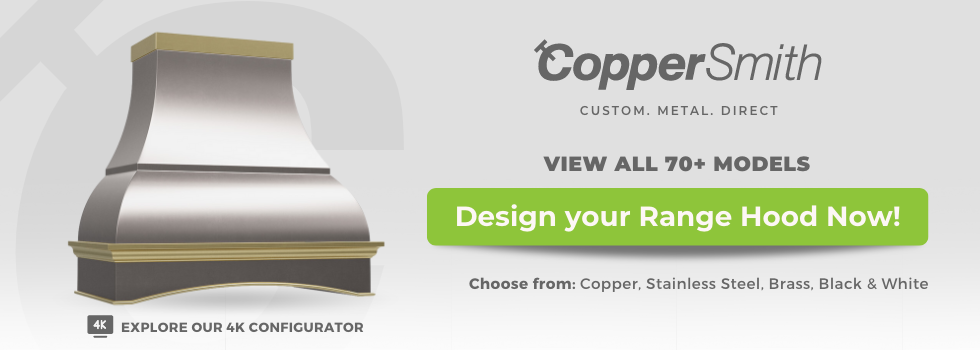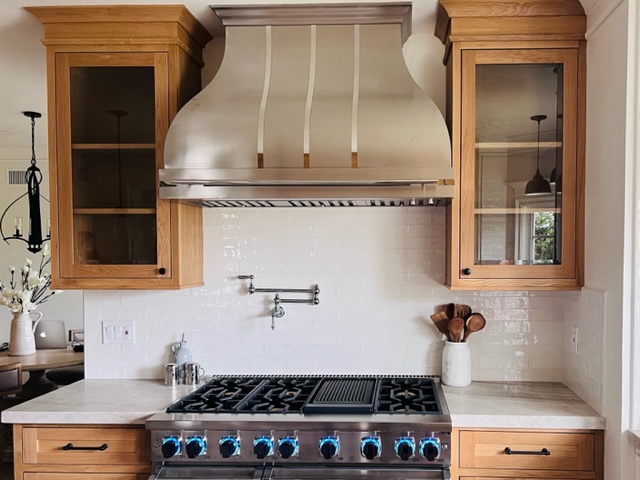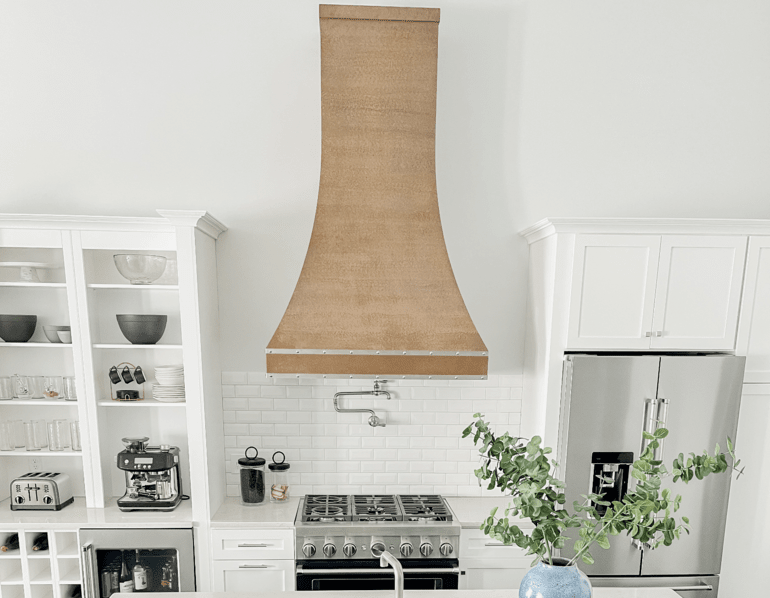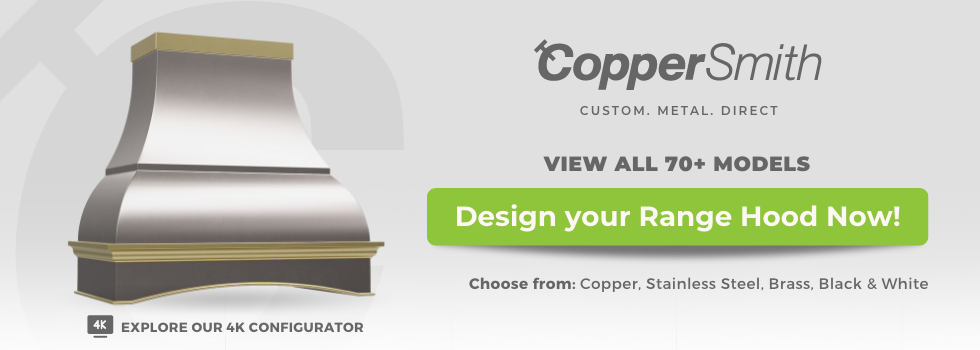Good range hoods perform a crucial function. Maintaining the quality of your air and protecting your lungs and home from harmful pollutants is no small task.
But the best range hood, a truly great range hood, performs this technical task while contributing something indelible to the look of your home. The best range hoods must be made with a level of care that takes commitment to craft and customer - that synthesis is World CopperSmith's mission.
World CopperSmith's standard
We simply aren't satisfied with anything but the best. We start with the best materials for the job - pure copper, stainless steel, and brass. Then we bring our expert craftsmen to the task. With your personalized customizations, we hand-make your ideal range hood to the most granular level of detail.
Who makes the most reliable range hoods?
Apart from being beautiful objects, the functionality and reliability of our range hoods is our foremost concern. Your CopperSmith range hood will perform its ventilating role effectively, and our construction is designed to last for years to come.
The many range hoods of CopperSmith
Every kitchen is different, which is why we offer a comprehensive line of different hoods.
Wall-mounted range hoods
Perfect for any stove or oven against a wall, these hoods install into free wall space above your cooktop.

Island range hoods
These hoods install into the ceiling above an island stovetop, creating a commanding centerpiece to draw the eye and purge the space of polluted air simultaneously.

Under-Cabinet Range hoods
An under-cabinet range hood is akin to the wall-mounted but is specially designed to fit snugly underneath existing cabinetry, so you don't have to disturb the cohesion of your space.
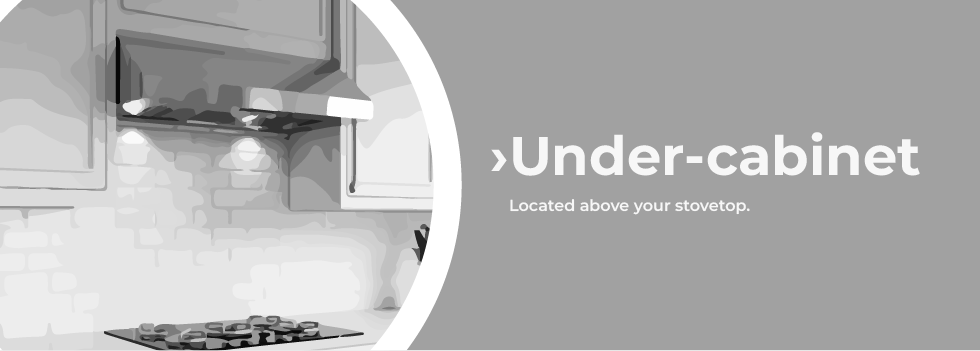
Ducted vs. ductless
The choice of whether to duct your range hood is one of the most important in this process. A ducted range hood sends all of your polluted air outside through mesh filters and ductwork, removing it entirely from your space. A ductless range hood, on the other hand, filters the air completely in-unit, utilizing a heavy-duty charcoal filter. The filtered air is then recirculated back into your space, which is why another name for this kind of hood is a "recirculating hood."
Deciding by type
The choice between ducted and ductless can be made simpler by considering the kind of range hood you need. If you need a wall-mounted range hood on an exterior facing wall, then the additional ductwork required to vent to the outdoors will be minimal. If you are installing an island range hood, or if your wall mount range hood is against an interior wall, then the ductwork will be more extensive and you might choose to go ductless. Any licensed HVAC professional should be able to give you an estimate for the ductwork you need.
Are recirculating range hoods any good?
Ductless range hoods are just as effective in cleaning your air as ducted range hoods. The only difference in functionality is that, since the air never leaves your space completely in a ductless model, heat and moisture can linger in your space. For most, this is no problem, but if cooling your kitchen is a high priority for you, you may prefer a ducted hood.
Choose a convertible range hood with CopperSmith's Ductless Conversion Kit, which can turn a ducted hood ductless in just a few easy steps.
Does a range hood have to vent outside?
If your hood is ductless, then you don't need any ducting whatsoever. But if your hood is ducted, then the ductwork must lead to the outdoors and never to an attic or crawlspace. Your kitchen exhaust, comprised of oils and cooking gases, cannot be allowed to accumulate in an indoor space - it would be a major hazard.
Other facets of your hood
You'll also need to determine the size, CFM rating, and design of your hood.
What size range hood do I need for a 30 range?
No matter the type of range hood you choose, it must be as large or larger as the cooktop you are ventilating. This means that, if your range is 30", your hood must be at least 30" to ensure proper exhaust capture.
How many CFM is good for a range hood?
The cubic feet per minute rating, a measure of a hood insert fan's power, can be determined by the space you are ventilating and the kind of cooking that will occur. For the average kitchen, a rating of 610 CFM or 835 CFM should be sufficient. CopperSmith offers fan powers from 290 to 1260 CFM - if your kitchen will only see light use, a lower power could work, while kitchens that enjoy grease-heavy or very frequent cooking may benefit from a higher power. If you're unsure of your choice, ask our expert team through our website, and they'll be happy to assist you.
How do I know what range hood to buy?
With so many design options available, narrowing your choice might seem daunting. Take in the overall aesthetic of your kitchen and begin to see how a range hood could add to the look and feel of the space. Perhaps a stainless steel hood is a bright accent the space needs. Alternatively, a rustic copper under-cabinet range hood could be the thing to add subtle warmth in just the right way.
Don't hesitate to order free material samples so you can compare them in-person, and reach out to our design team if you'd like our input - we'd love to help.
Shop the best with CopperSmith
We wouldn't say it if we didn't mean it - we make the very best range hoods using the highest quality of material and craftsmanship; just read our reviews. Your kitchen should be a sanctuary for the senses, and this belief has guided our pursuit of the best in range hood manufacturing. See for yourself and start your custom range hood order today!

